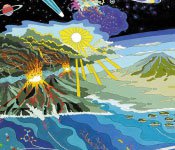
Although the physical environment that fostered primitive cellular life is still largely unconstrained, we can be reasonably confident that liquid water was required, together with a source of organic compounds and energy to drive polymerization reactions. There must also have been a process by which the compounds were sufficiently concentrated to undergo physical and chemical interactions. We are exploring self-assembly processes and polymerization reactions of organic compounds in natural hydrothermal environments and related laboratory simulations. We have found that macromolecules such as nucleic acids and proteins are readily encapsulated in membranous boundaries during wet-dry cycles such as those that would occur at the edges of hydrothermal springs in volcanic environments. The resulting structures are referred to as protocells, in that they exhibit certain properties of living cells and are models of the kinds of encapsulated macromolecular systems that would have led toward the first forms of cellular life. We have also determined that RNA-like polymers can be synthesized non-enzymatically from ordered arrays of mononucleotides in lipid microenvironments. We are now extending this approach to template-directed synthesis of DNA and RNA in which lipid-assisted polymerization serves as a model of an early stage of evolution toward an RNA World.
 A Talk With Jim Green
A Talk With Jim Green What Can Extant Genomes Reveal About Early DNA Metabolism?
What Can Extant Genomes Reveal About Early DNA Metabolism? What We Talk About When We Talk About Earth's Oxygenation
What We Talk About When We Talk About Earth's Oxygenation Bowling With Astrobiologists: A Twisted Path Toward the Origin of DNA
Bowling With Astrobiologists: A Twisted Path Toward the Origin of DNA